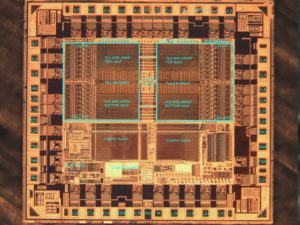Crack Microcomputer PIC16LC620 Encrypted Flash
Each PORTB pin is multiplexed with other functions. The pins and their combined functions are briefly described here. For specific information about individual functions such as the LCD or interrupts, refer to the appropriate section in this datasheet which is also useful for Crack Microcomputer PIC16LC620 Encrypted Flash.
PORTC is an 8-bit bidirectional port. PORTC is multiplexed with several peripheral functions. PORTC pins have Schmitt Trigger input buffers.

Crack Microcomputer PIC16LC620 Encrypted Flash
All PORTC pins have latch bits (PORTC register). They, when written, will modify the contents of the PORTC latch; thus, modifying the value driven out on a pin if the corresponding TRISC bit is configured for output from Crack Microcomputer PIC16LC620 Encrypted Flash.
Each PORTC pin is multiplexed with other functions. The pins and their combined functions are briefly described here. For specific information about individual functions such as the LCD or SSP, refer to the appropriate section in this data sheet.
The PIC16LC620 has a wide variety of clock sources and selection features to allow it to be used in a wide range of applications while maximizing performance and minimizing power consumption in the process of Crack MCU PIC18F45K22 Heximal.
Figure 4-1 illustrates a block diagram of the PIC16LC620 clock sources. Clock sources can be configured from external oscillators, quartz crystal resonators, ceramic resonators, and Resistor-Capacitor (RC) circuits.
In addition, the system clock source can be configured from one of two internal oscillators, with a choice of speeds selectable via encrypted flash by MCU Reading. Additional clock features of microcomputer include:
Fail-Safe Clock Monitor (FSCM) designed to Two-Speed Clock Start-up mode, whichSelectable system clock source between external or internal via encrypted flash. minimizes latency between external oscillator start-up and code execution. detect a failure of the external clock source (LP, XT, HS, EC or RC modes) and switch to the Internal Oscillator from Crack Microcomputer PIC16LC620 Encrypted Flash.
The PIC16LC620 can be configured in one of eight clock modes.
EC – External clock with I/O on RA6.
LP – Low-gain Crystal or Ceramic Resonator
Oscillator mode.
XT – Medium-gain Crystal or Ceramic Resonator Oscillator mode.
HS – High-gain Crystal or Ceramic Resonator mode.
RC – External Resistor-Capacitor (RC) with
FOSC/4 output on RA6.
RCIO – External Resistor-Capacitor with I/O on RA6.
INTOSC – Internal oscillator with FOSC/4 output on RA6 and I/O on RA7.
INTOSCIO – Internal oscillator with I/O on RA6 and RA7.

